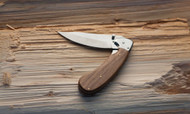The Different Types of Knife Tangs Explained
May 22 2023 - 8:02
There’s a lot of jargon in the knife community. One word you’ll often hear is “tang.” Are you unfamiliar with this term? You’re not alone. But it’s an integral part of knife anatomy, and knowing the different types is important. Continue reading to understand the different kinds of knife tangs and what the term means.
What Is a Knife Tang?
Before we explain the different types of knife tangs, let’s first define what a knife tang is. In simple terms, the knife tang is the portion of the blade that extends into the handle. It’s important to know that tangs aren’t exclusive to knives. You can find them on screwdrivers, machetes, swords, and chisels.
The functionality of the tang is to provide the blade stability and support the structural integrity of the knife. It allows the knife to cut through thicker and more substantial objects without breaking.
Extended Tang
An extended tang will go beyond the handle’s end. Typically, you’ll find a lanyard hole or pommel on the back of an extended tang. Extended tangs are incredibly stable and strong, and you can use the extension to hammer small items.
Keep in mind that extended tangs are a heavier knife option. Some people don’t like the extra metal hanging off the back, but most don’t have an issue with it.
Many knife enthusiasts appreciate extended tang knives for outdoor and survival activities due to their strength and durability. They can also crack open nuts, hammer in tent stakes, and function as small baton sticks.
Full Tang
A full tang knife has a tang the same width and length as the handle. Typically, you can observe the tang sandwiched between two knife scales. Full tang knives are strong and durable because you grasp a significant tang portion. They have fewer stress points, which causes many of them to break.
Many knife enthusiasts appreciate using a full tang over other options. Thanks to their incredible durability and strength, full-tang knives are excellent for outdoor and survival uses. A full-tang knife can hold up in demanding situations that require a robust and durable knife.
Encapsulated Tang
If you’ve seen a knife where the handle material encloses the tang, this is an encapsulated tang. It allows for extra precision and a strong knife. There aren’t many disadvantages to this tang. Knife manufacturers fill a mold with the handle material and insert the tang into the mold.
Many hunters prefer using an encapsulated tang knife. They’re precise, sturdy, and strong—what’s not to love? If you’re an avid hunter, you’ll want to invest in an encapsulated tang knife.
Partial Tang
A partial tang knife is one where the tang extends partly into the handle material. It can reach somewhere from less than halfway to past the halfway point. It’s always less than a full tang.
Weight and design are the two significant benefits of using a partial tang knife, but they don’t have the same strength as any full-tang knife. They are ideal for cooking, everyday carry, and camping. They aren’t the best option for intensive tasks for survival knives.
Now that you understand the different types of knife tangs, you can find the right one for you. Decide what the primary use of your knife will be, and consider investing in a few different types to cover all purposes.
The Knife Connection offers Great Eastern cutlery knives, which have a reputation for being the premier cutlery knives on the market. Don’t hesitate and browse this collection today.
